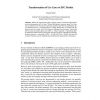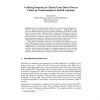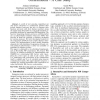MBUI
2004
14 years 3 months ago
2004
Users require flexibility when interacting with information systems to contend with changing business processes, and to support diverse workflow. Model-based user interface design...
ISTA
2004
14 years 3 months ago
2004
: Organizations require material resources, human resources, and business processes to produce goods and services. There is an available market for material resources as well as hu...
EPK
2006
14 years 3 months ago
2006
: Within the requirements phase of many projects, functional requirements are often documented as Use Cases. Within SOA projects, however, these Use Cases are not sufficient since ...
EPK
2006
14 years 3 months ago
2006
Abstract: Event-driven Process Chains (EPCs) are a commonly used modelling technique for design and documentation of business processes. Although EPCs have an easy-to-understand no...
DAGSTUHL
2006
14 years 3 months ago
2006
Service oriented software architectures that are aware of business processes will form the core of
DGO
2004
14 years 3 months ago
2004
E-Gov projects have an increasing influence on how government business processes evolve and change. While early e-Gov projects focused on government-to-public information and inte...
CSREAEEE
2006
14 years 3 months ago
2006
A world of ever growing competition not only forces enterprises to continuously optimise their private business processes but also to integrate their business processes with their ...
BIS
2006
14 years 3 months ago
2006
Business processes can be described with diagrams, e.g. BPMN diagrams, or as text. Use cases are a text-based notation. They are semiformal: a business process is expressed as a s...
APCCM
2006
14 years 3 months ago
2006
Current enterprise systems rely heavily on the modelling and enactment of business processes. One of the key criteria for a business process is to represent not just the behaviour...
ACSW
2004
14 years 3 months ago
2004
Business processes are often likely to undergo drastic changes and hence the workflow systems that model, simulate and enact these processes should support the monitoring and cont...



